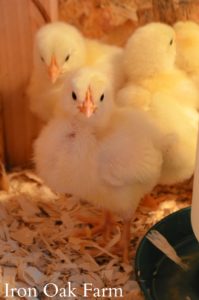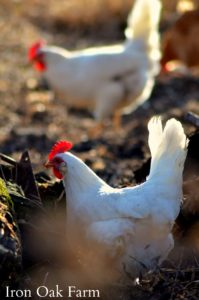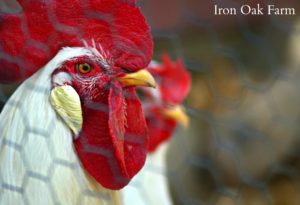 I feel like sometimes the Leghorn is an overlooked breed. With so many fancy breeds to choose from, a plain, typical, all white bird that lays a white egg is somewhat mundane when compared to Frizzles, Silkies, Polish, or some of the beautiful colors and feather patterns available.
I feel like sometimes the Leghorn is an overlooked breed. With so many fancy breeds to choose from, a plain, typical, all white bird that lays a white egg is somewhat mundane when compared to Frizzles, Silkies, Polish, or some of the beautiful colors and feather patterns available.
 But if you’re looking for a constant supply of eggs, the Leghorn is your breed.
But if you’re looking for a constant supply of eggs, the Leghorn is your breed.
If anything, the leghorn is reliable and an easy keeper.
We have 5 Leghorn hens and we get 5 perfectly shaped large/extra large white eggs every…single…day. They’ve not missed a day since they started laying mid-August.
 The chicks were born on March 1st and I collected our first egg on August 9th. So, 162 days from birth to layer. Not too shabby.
The chicks were born on March 1st and I collected our first egg on August 9th. So, 162 days from birth to layer. Not too shabby.
The Leghorn is a Mediterranean breed. It is a smaller non-bantam chicken, lean and sleek and has somewhat of an upright stance, especially the roosters.
A good hen has been known to lay up to 300 eggs per year!
Because of its ability to lay so many eggs, it is most often the breed of choice for commercial egg producers. It is also great at converting feed into eggs. Because of its small stature, they don’t eat as much as a larger breed which makes them the perfect chicken choice for high production facilities.
 While it’s been said that Leghorns will tolerate confined spaces better than other breeds, I find them to be excitable birds, less domesticated and prone to wandering. They have a wildness that makes them less interested in human interaction and they are excellent flyers. They love to roost high!
While it’s been said that Leghorns will tolerate confined spaces better than other breeds, I find them to be excitable birds, less domesticated and prone to wandering. They have a wildness that makes them less interested in human interaction and they are excellent flyers. They love to roost high!
Though it is often used in the factory setting, the Leghorn is considered a Heritage breed. It was developed in Italy and while the white variety is the most common, and the best egg layer, they come in an assortment of colors.
Because Leghorns are a lean bird (Males average 6 lbs, females average 4lbs) they don’t do as well in winter climates as a plump Wyandotte for example. The single comb variety is also prone to frostbite, especially along the narrow tips of the combs.
 Leghorn chicks are easy to locate. Many feed stores will get several shipments of pullets in each spring. It can, however, be difficult to locate a rooster. Because of the demand for egg-laying pullets, straight run shipments can be hard to find. I was lucky enough to get a rooster out of the pullet bin this spring. I selected the largest chicks in the bin, hoping for a rooster and it worked.
Leghorn chicks are easy to locate. Many feed stores will get several shipments of pullets in each spring. It can, however, be difficult to locate a rooster. Because of the demand for egg-laying pullets, straight run shipments can be hard to find. I was lucky enough to get a rooster out of the pullet bin this spring. I selected the largest chicks in the bin, hoping for a rooster and it worked.
If you plan on breeding Leghorns as I do, you will probably want to invest in an incubator. Most of the desire to go broody has been bred out of this breed and the chicks will have to be hatched artificially.
 I can’t write a post about Leghorn’s and not mention the popular Warner Brother’s cartoon Foghorn Leghorn. The Foghorn character was introduced in 1946 and ran until 1963 starring in 28 cartoons. I remember Foghorn appearing on re-runs of the Bugs Bunny show that aired as part of the Saturday Morning cartoon lineup…I’m dating myself here. Do kids watch Bugs Bunny anymore?
I can’t write a post about Leghorn’s and not mention the popular Warner Brother’s cartoon Foghorn Leghorn. The Foghorn character was introduced in 1946 and ran until 1963 starring in 28 cartoons. I remember Foghorn appearing on re-runs of the Bugs Bunny show that aired as part of the Saturday Morning cartoon lineup…I’m dating myself here. Do kids watch Bugs Bunny anymore?
Do you raise Leghorns? Are they a breed favorite? Let us know what you think by leaving a comment below, or visit the Community Chickens Facebook page.












